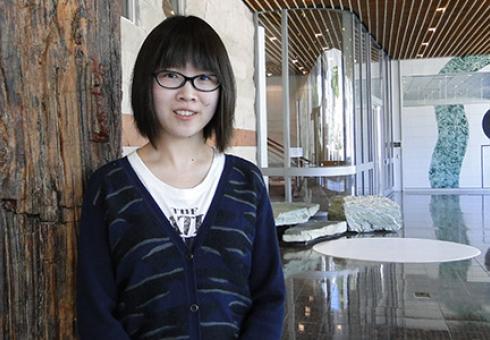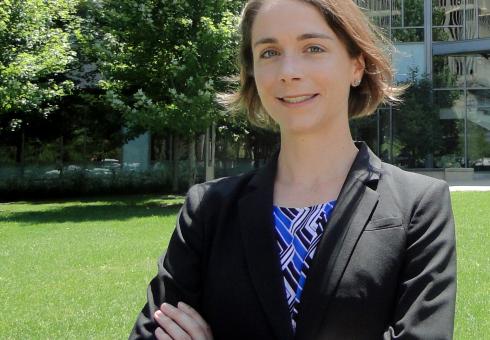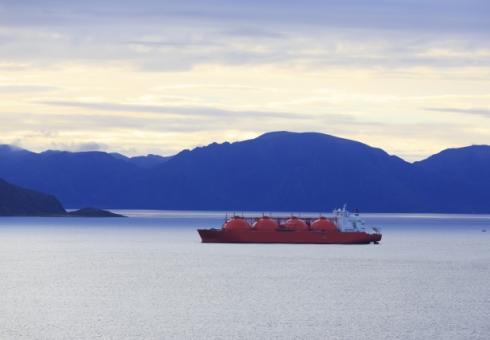News + Media
 |
||
|
|
Photo: Dara Entekhabi, courtesy of Len Rubenstein, MIT Spectrum |
by Audrey Resutek | MIT Joint Program on the Science and Policy of Global Change
On January 29, 2015, a Delta II rocket launched from Vandenberg Air Force Base will carry the SMAP Observatory, the first satellite designed exclusively to monitor soil moisture, into orbit. Once there, the satellite will make a map of the Earth’s soil moisture every three days—creating a measurement with the potential to dramatically improve weather forecasts and predictions of climate change.
It’s been a long journey to get to this point, as Prof. Dara Entekhabi, the science team leader of the NASA mission and a researcher at the Joint Program on the Science and Policy of Global Change, can attest. SMAP, which stands for Soil Moisture Active Passive, was first conceived in 1999. Over the last 15 years, Entekhabi has led a team of researchers at MIT and other universities, the NASA Jet Propulsion Laboratory, and the NASA Goddard Space Flight Center working on the satellite.
“The team has stuck together,” notes Entekhabi, who holds a joint appointment in MIT’s Department of Civil and Environmental Engineering and the Department of Earth, Atmospheric and Planetary Sciences. “It’s almost the same people as when we started working on SMAP.”
Once SMAP is in orbit it will measure moisture in the first five centimeters of the soil, using two instruments—active microwave radar and a passive microwave radiometer. The data transmitted back to Earth will represent a huge leap forward for scientists studying how the Earth works.
Unconventional Data
Entekhabi has spent his career learning about the Earth through collecting data, and the information collected by the SMAP Observatory will fill a major gap in our understanding.
“I was always into data and the environment, and reconstructing old records,” says Entekhabi. “I eventually became interested in creating new sources of data—unconventional data. Which is how I became involved with SMAP.”
SMAP is the first NASA mission dedicated to studying soil moisture and freeze/thaw data, which indicates the start and end of the growing season. Because of this, current records are spotty at best, and are based mostly on data from sparse ground stations and readings from satellites primarily designed for other uses.
 |
|
|
Photo: Artist's rendering of the SMAP spacecraft, courtesy of NASA/JPL. |
The mission is somewhat unusual, Entekhabi says, because the long development period gave the mission team time to cultivate a community of early data adopters, who have already developed applications for the data. The information produced by SMAP will be tailored to fit these users’ needs—allowing them to immediately put the data to use for forecasting and research.
“This is a path-breaking approach for NASA, because the applications are woven into the science of the mission. So, it’s broad basic research, as well as application,” says Entekhabi.
There is an impressive range of uses for soil moisture data. These include the obvious, like improving weather and climate forecasting; estimating agricultural productivity; tracking droughts, floods and landslides; to the less obvious, such as providing early warnings of famine in areas dependent on rain-fed crops; determining soil hardness on military transportation routes, and forecasting the density of the lower atmosphere, which determines how much lift an airplane has.
The lack of information about soil moisture is also a problem for basic Earth science research, because soil moisture links the three major cycles of the Earth system—the water, energy, and carbon cycles—together. Without accurate soil moisture data it’s nearly impossible to accurately trace the movement of water through these three systems.
“These are basically three gears that are locked together,” Entekhabi says. “If we don’t get this right in models, because we don’t know what the linkage is, it’s a problem. Measuring soil moisture is important because it’s the pivot that links these three gears.”
 |
||
|
|
Photo: SMAP lowered into place, courtesy of NASA/JPL-Caltech. |
|
Understanding soil moisture will likely greatly improve the accuracy of weather forecasts at a fraction of the cost of other measures, like beefing up computing power to support higher resolution weather models. It will also improve how models estimate how climate change will affect precipitation, which, up until now, has been notoriously difficult to pin down.
“All the models agree on global temperature; you can’t get that wrong,” Entekhabi says. “But what’s going to happen with regional water availability, regional precipitation, the models don’t even agree in sign—some of them are positive, some of them are negative—let alone magnitude.”
Taking Extreme Weather’s Fingerprint
Entekhabi’s work on the water cycle and soil moisture spans decades, starting with his doctoral work at MIT, where he worked to improve how climate models account for land surface moisture. He joined MIT’s faculty in 1991 and has been involved with the Joint Program since its creation in the early 1990s.
“A major question in the field today is what is climate change going to do to the water cycle?” Entekhabi says. “The real challenge is predicting the future of water availability at a regional scale.“
To address this issue, Entekhabi worked with the Joint Program to create a new way of predicting how climate change will affect the frequency and severity of extreme precipitation. The method takes advantage of the fact that climate models do a good job of simulating the large-scale atmospheric events that lead to extreme precipitation, even though they’re bad at predicting the precipitation itself. The method bypasses climate models’ built-in precipitation parameterizations, and instead looks for the large-scale conditions that have been associated with extreme weather events in the past.
“What we’re doing is basically fingerprinting,” Entekhabi says. “We use the historical record to find a fingerprint, or pattern of what’s going on in the large-scale climate that causes extreme weather.
The technique, called an “analogue” method because it does not directly simulate precipitation within the model, gives more accurate reproductions of past extreme weather events than climate models alone. Once the patterns associated with extreme weather—either very wet or very dry—are identified, the next step is to look at future changes in these patterns in a climate model.
Entekhabi is currently working to identify these patterns across several regions. In one example, he studied over 100 years of precipitation data for the region around Mumbai, where the monsoon season can cause devastating floods in densely populated areas. The monsoons that caused the worst flooding left a distinct atmospheric fingerprint, he found.
“The fingerprint of the monsoon is much larger than the local flooding in Mumbai,” Entekhabi says. “The circulation patterns extends all the way to the Arabian Sea and the coast of East Africa. Basically a long arc of vapor from the Arabian Gulf gets blocked, and it just sits there and rains a lot.”
The method can be applied to any event in any region, as long as it is associated with changes in large-scale atmospheric conditions. Working with Dr. Adam Schlosser, a senior research scientist and assistant director for science research at the Joint Program, Entekhabi is currently applying the analogue method to West Africa, a region that relies on rain-fed agriculture for most of its food. Most of the rain in the region falls during a three-month rainy season in the summer, and what happens in the rainy season can make or break the area’s food supplies.
“Models will always be uncertain once you start looking into the future,” Entekhabi says. “SMAP is one way we’re trying to improve the quality of models—by looking at how the water and carbon cycles fit together. The analogue approach is another way of attacking the challenge of regional water availability from an entirely different angle.”
For now, Entekhabi is turning his attention skyward. In the Fall, Entekhabi traveled to Southern California, where SMAP was being loaded into a rocket at the Jet Propulsion Laboratory. He’ll remain there through the spring, while SMAP is being calibrated.
“It’s been a long trek,” Entekhabi says. “But every single screw on SMAP has been reviewed and reviewed and reviewed. Right now there’s no more testing, no more touching the satellite. There’s no looking back now.”
Graduate Student and Rwandan native Jimmy Gasore and Research Scientist Kat Potter are working to establish Africa’s first climate observatory. In this video, they talk with MIT’s Earth, Atmospheric and Planetary Sciences group about the project.
Ronald G. Prinn, the TEPCO Professor of Atmospheric Chemistry, Director of the Center for Global Change Science and Codirector of the Joint Program on Science and Policy of Global Change at MIT, talks with MIT’s Earth, Atmospheric and Planetary Sciences group about the Rwandan Climate Observatory project.
The announcement of a joint pledge to cut emissions between the world's two largest carbon emitters: the United States and China, made global headlines when it was announced in November. In this interview, Valerie Karplus, an asssistant professor in MIT's Sloan School of Managment, discusses the details of the deal.
by Jesse Jenkins | The Energy Collective
Jesse Jenkins: Even before world leaders descended on Lima, Peru this week for United Nations-sponsored climate negotiations, climate diplomacy made global headlines with the joint announcement of a partnership between the world's two largest carbon emitters: the United States and China.
The joint pledge to cut greenhouse gas emissions and collaborate on clean energy technology development has been hailed as a potential sea change in the tone and substance of international climate mitigation efforts.
To dig in to the details of this U.S.-China climate partnership, I caught up this week with Valerie Karplus, an assistant professor at the Massachusetts Institute of Technology's Sloan School of Management and Director of the Tsinghua-MIT China Energy Program.
An expert on both American and Chinese energy and climate policy, Prof. Karplus and I explored what the climate deal means for domestic energy policy in each nation, chatted about the major drivers of emissions growth in China, and considered implications of the new emissions pledges for international climate negotiations.
Study shows that the effects of smaller eruptions have been underestimated in climate models.
by David L. Chandler | MIT News Office
New research shows that relatively small volcanic eruptions can increase aerosol particles in the atmosphere, temporarily mitigating the global warming caused by greenhouse gases. The impact of such smaller eruptions has been underestimated in climate models, the researchers say, and helps to account for a discrepancy between those models and the actual temperatures observed over the last 15 years.

The findings are reported in a paper in the journal Geophysical Review Letters, co-authored by MIT Professor Susan Solomon, postdoc David Ridley, and 15 others. They help to explain the apparent slowdown in the pace of global warming recorded over the last 10 to 15 years — possibly explaining as much as half of that slowdown, the researchers say.
“We’ve learned a lot of new things about how the Earth’s climate changes, not just from year to year but from decade to decade, as a result of recent research,” says Solomon, the Ellen Swallow Richards Professor of Atmospheric Chemistry and Climate Science at MIT. “Several independent sets of observations show that relatively modest volcanic eruptions are important.”
For the last several years, “It’s been quite clear that the observed trends are not following what the models say,” Ridley adds: While the overall warming trend continues, its rate is slower than projected. Previous research has suggested that some of that discrepancy can be accounted for by an increase in the amount of warm water being carried down to the deep ocean, but other processes can also contribute.
The cooling effect of large volcanic eruptions, such as that of Mount Pinatubo in the Philippines in 1991, was already widely recognized; the new work shows that smaller eruptions can have a significant cooling effect as well, and provides a better estimate of how much of the recent reduction in warming could be explained by such eruptions: about 30 to 50 percent of the discrepancy, the team found.
The team found that small eruptions produce a significant amount of aerosol particles, which reflect sunlight, in a region of the upper atmosphere that is relatively poorly monitored: Satellites can provide good data about the atmosphere down to around 15 kilometers above ground level, below which clouds interfere. The team filled in the missing region using multiple balloon, laser radar (lidar), and ground-based measurements.
Aerosols in that intermediate zone, from about a dozen modest eruptions around the world during the last 15 years, may double previous estimates of the cooling effect of eruptions, Ridley says.
“It’s always exciting in science when you can find multiple measurements that lead to a common conclusion,” Solomon adds. “Several independent sets of observations now show that relatively modest volcanic eruptions are more important for global climate than previously thought.”
Overall, these smaller eruptions have lowered the increase of global temperature since 2000 by 0.05 to 0.12 degrees Celsius, counteracting some of the warming that would otherwise have occurred. Now, using this new information, groups that carry out climate modeling can update their models to more accurately project global climate change over the coming decades, Ridley says.
Alan Robock, a professor of environmental sciences at Rutgers University, says, “This work helps to better quantify the impacts of the most important natural cause of climate change, volcanic eruptions. We have an imperfect observational system for volcanic aerosols, and this work exploits some previously unused sources of information to better quantify the effects of small eruptions for the past decade.”
Robock, who was not involved in this research, adds that in light of these findings, “We need a more robust observing system for volcanic aerosols, to do a better job of measuring future small eruptions.”
Ridley and Solomon were the lead authors of this paper, joining authors from Wyoming, Russia, Germany, Japan, California, New York, Virginia, Colorado, and the U.K. The work was supported by the National Science Foundation, the Ministry of Science and Education of the Russian Federation, and the Russian Science Foundation.
MIT researcher Sergey Paltsev discusses the outlook for LNG trading over the next several decades.
Until recently, most natural gas trade has been limited to the regional scale due to the challenges of transporting gas over long distances. Over the last decade, Liquefied Natural Gas (LNG)—an option that reduces the volume of gas about 600 times allowing for transportation by ship—has created an opportunity for expansion of the international market for natural gas.
In this report, Joint Program researchers examine the prospects for LNG trade over the coming decades. Part of a collaborative project between MIT and Cyprus, the report estimates that LNG trade volumes will increase from about 240 Mt LNG in 2014 to about 340–360 Mt LNG in 2021.
Sergey Paltsev, coauthor of the report and a principle research scientist and assistant director for economic research at the Joint Program, discusses some of the report’s findings.
Q. The increase in trade volumes is largely the result of new LNG infrastructure projects. What’s causing the upswing in construction?
A. The main force driving many of these new LNG projects is the high price of LNG in Asian markets. The cost of natural gas in the US right now is about $4/mmbtu. If you add in liquefaction and transportation costs it’s about $10-11, whereas Asian prices up until recently were $14-$16. So, with this price differential an LNG exporting operation can be quite profitable. Actually, the trend that we’re seeing with new LNG projects is the opposite of what we saw less than ten years ago. In 2005 and 2006, US companies were building regasification capacity, or in other words, terminals to get gas into the country. Now, a lot of infrastructure is sitting idle because US prices are so low. Many of the current U.S. projects are actually taking the existing import terminals and converting them into liquefaction facilities, or export terminals.
This underscores why long-term market analysis is so important. Since the development and construction periods of these projects are so long, 4-5 years on average, any projects started now are not going to ship gas until 2020; and those facilities are going to be operational for at least 20–30 years. So that means you need to understand the market dynamics not just today, and probably not just in 2020 when you start operation, but also in 2030, 2040, and 2050.
Q. Is the US going to become a major player in the LNG market?
A. There are a lot of projects that are in the permitting process right now. To export LNG from the US, you need approval from the DOE and the Federal Energy Regulatory Commission (FERC). If you add up all of the applications which are currently in the pipeline and those projects labeled by FERC as potential, the total is more than half of the US current natural gas production. Obviously many of these are not going to happen, but everyone is trying to capitalize now. There are currently only two US projects that are likely to be completed before 2020—the Sabine Pass and Corpus Christi projects run by Cheniere Energy, Inc. In comparison to the current very limited exports from the US, these two projects will substantially increase exports from the US. So the US will have some share of the LNG market, but I don’t see it becoming the dominant player.
Most of the exports from the US will likely go to Asia, and one thing to note is that the price of LNG in Asia will start to come down as shipments of LNG increase. Over the next ten years, the global price of LNG will equalize—in other words, the price will be the same in all regions, with the main difference being the cost of transportation. So, the price differential between the US and Asia is going to narrow.
Q. What’s the long-term prognosis? Have we entered a golden age of LNG trading?
A. LNG is poised for substantial increases. Looking at the supply side, the LNG market is going to expand. Suppliers who have traditionally been in the pipeline business, like Russia, are now actively pursuing LNG projects. Again, this growth is being driven by the high price of LNG in Asia, which isn’t going to last forever. So some of the hype is going to diminish, but even with a lower Asian price this mode of natural gas trade is still going to expand.
Future demand is harder to estimate because there’s more uncertainty there, especially when much of the future demand will be determined by carbon policies, especially in China and India. Developing countries are expected to dominate new demand, and this trend is likely to continue. In addition, the LNG technology keeps evolving. In our report we discuss the potential effects of floating LNG (FLNG)—ships that liquefy gas onboard. FLNG could have a substantial impact on the industry if proven viable, since it removes the need to build permanent infrastructure.





